MAT | Maturation tanks – the secondary fermentation vessels

Maturation tanks – pressure fermentors for the secondary fermenation of beer/cider

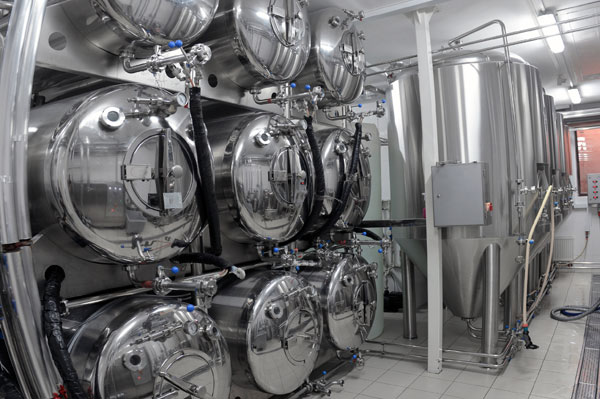 After the primary fermentation process of wort (or fruit must), follows the process of the maturation of beer (or carbonization of cider) in the maturation tanks (also called lager tanks). They are special beer tanks designed only for second phase of the beer fermentation process. During this production phase the beer is slowly fermenting in low temperature under pressure and it is naturaly saturated with the carbon dioxide which is formed during the remaining yeast activity. This way the beer acquires its final savour.
After the primary fermentation process of wort (or fruit must), follows the process of the maturation of beer (or carbonization of cider) in the maturation tanks (also called lager tanks). They are special beer tanks designed only for second phase of the beer fermentation process. During this production phase the beer is slowly fermenting in low temperature under pressure and it is naturaly saturated with the carbon dioxide which is formed during the remaining yeast activity. This way the beer acquires its final savour.
The secondary beer fermentation process – the beer maturation – is the longest stage of the beer production process. The length of the beer maturation process depends on the chosen recipe, temperature and the set pressure in the maturation tank. Maturation of bottom fermented beer with EPM 10 % takes two to three weeks, light lager with EPM 12% at least 30 days, beer with special EPM above 12 % takes 60 days up to several months. EPM is a Czech brewery unit and it means how many percent of extract is in origin wort before the beer fermentation start.
The time of the beer maturation process, the batch size and frequency of wort production is important for the decisions on the required number of maturation tanks in every brewery.
Position of the maturation tanks in typical Czech craft brewery :
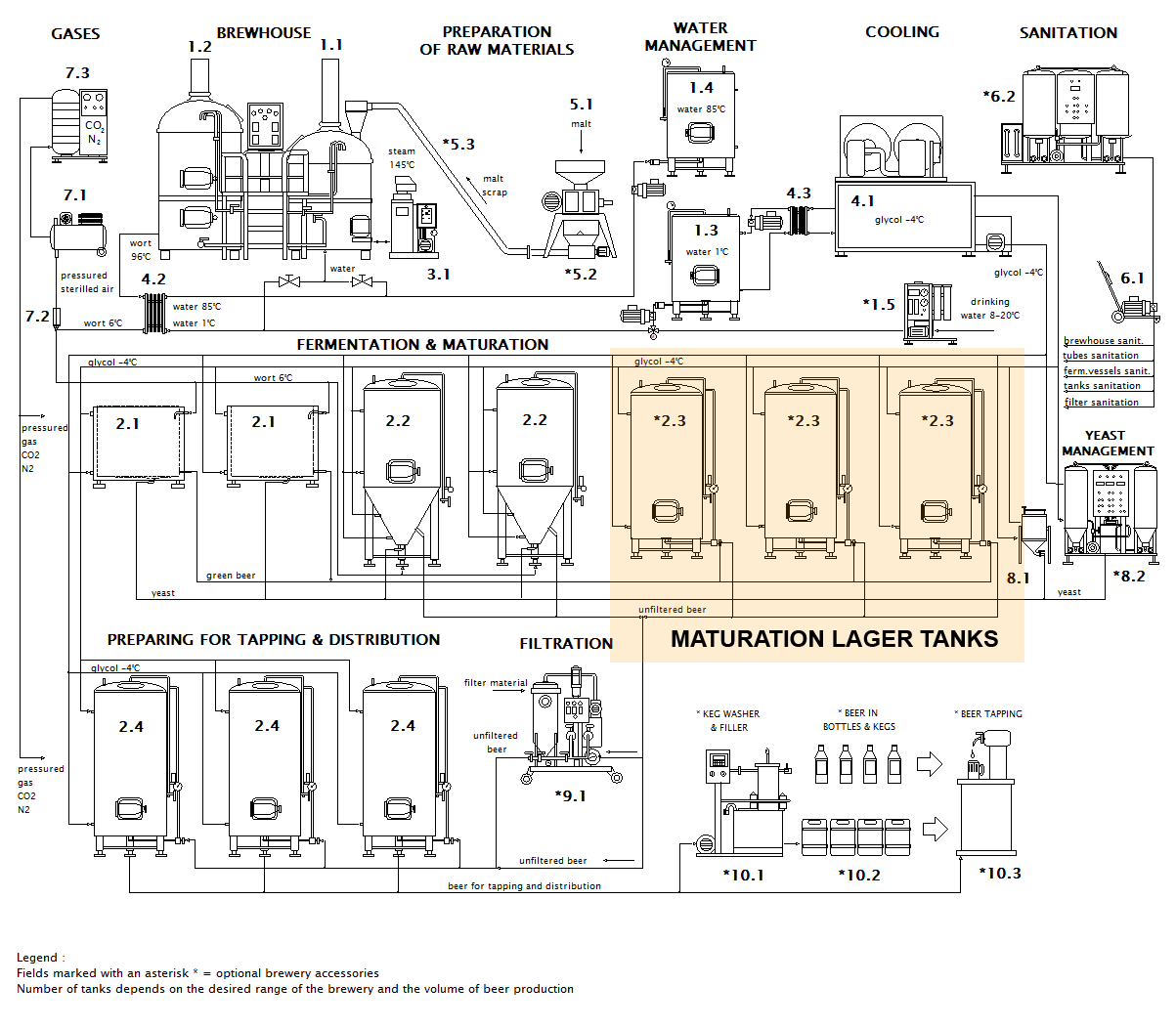
Equipment of the MBTVI beer maturation tank (insulated, vertical, cooled with water/glycol) :
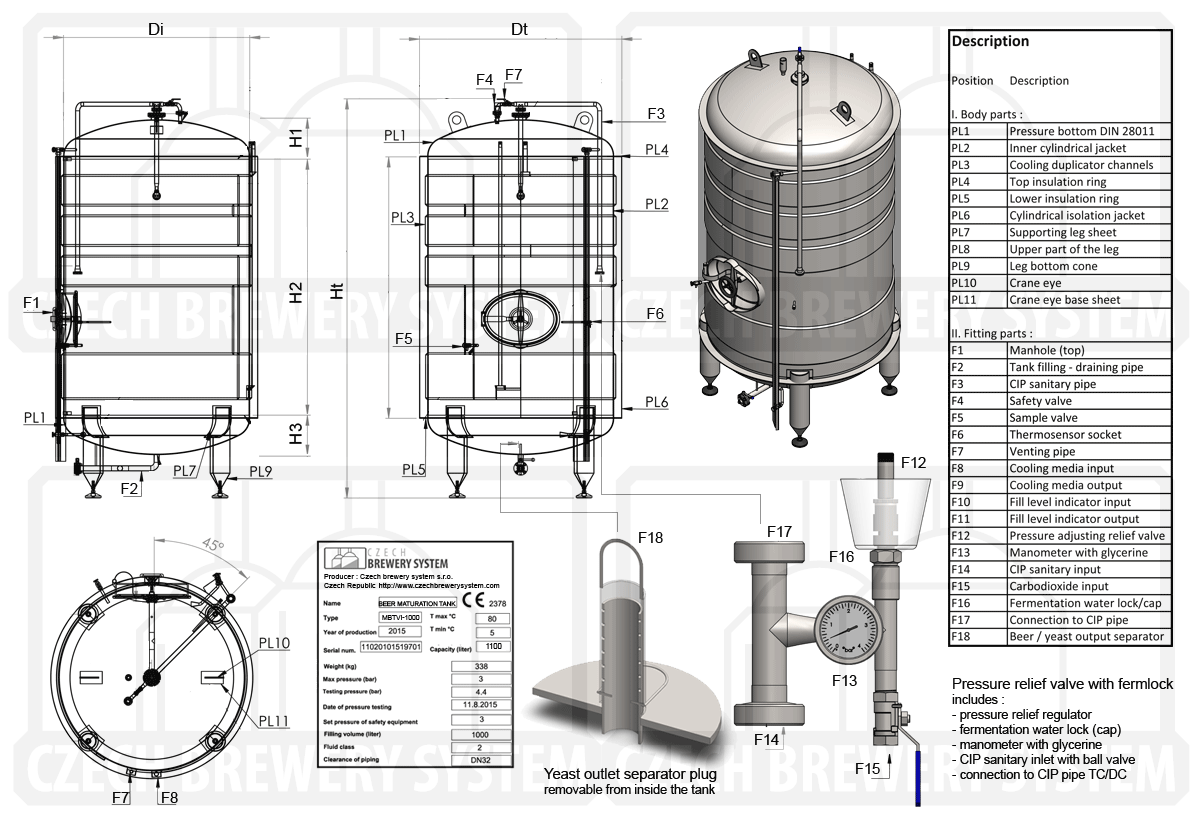
Equipment of the MBTVN beer maturation tank (non-insulated, vertical, cooled with air) :
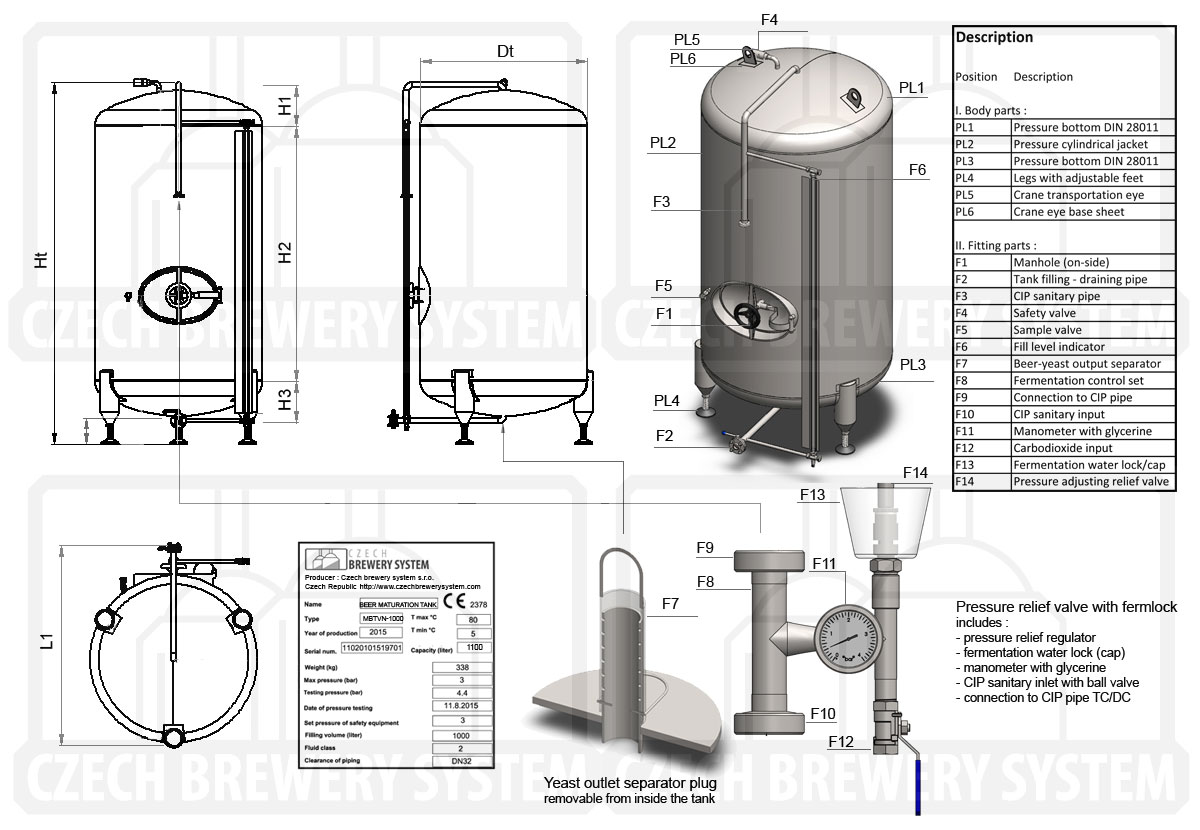
Equipment of the MBTHN beer maturation tank (non-insulated, horizontal, cooled with air) :
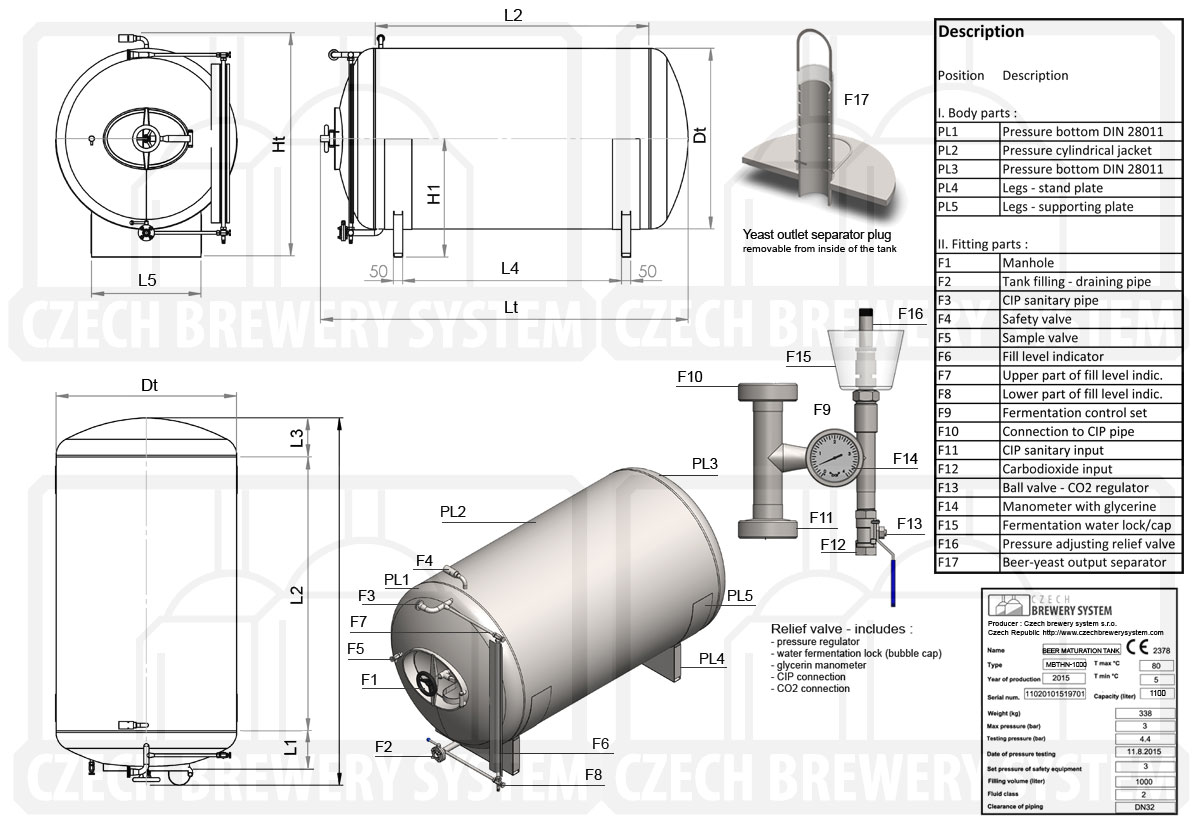
Standard equipment of the maturation tank :
- Adjustable pressure valve with a manometer and fermentation lock – A special armature that is designed especially to controlled fermentation and maturation of the beer (or sparkline wine or cider) under accurate set pressure.
- Separator of sedimented yeast – a special removable short pipe that is designed to easy separation of yeast under a bottom from clear product above the yeast layer
- Cooling channels – duplicators for circulating of coolant in the cooling jacket (one, two or more according type of the tank)
- PUR insulation – polyurethane insulation with thickness according to the size of the tank and the target environment (standard = 50mm )
- Outer jacket of the tank of stainless steel – Kind of the surface finishing (standard = grinded) choosed by customer.
- Guaranteed inner surface roughness : Ra < 0.8 μm or less (grinded surfaces) / Ra < 0.5 μm or less (polished surfaces)
- Service door (manhole) on the upper arched bottom or on-site on the cylinder part, according to customer requirements (SQ = open inside / HQ = open outside)
- Bottom filling/emptying armature – The inlet / outlet pipe with a butterfly valve for filling tank, discharging of yeast and draining of full content of the tank
- Sanitizing ball-shower – CIP sanitizing ball-shower (SQ = statical / HQ = rotational) – one or more pcs
- Sanitation pipe – a multifunction pipe with a ball valve for connection of a sprayball, CIP station (cleaning, sanitizing), the adjustable pressure valve with manometer, CO2 inlet
- Sample valve – cleanable and sanitizable sampling cock for collection product samples
- Safety valve – double-acting overpressure (standard = 3.2 bar) and vaccum protection (0.2 bar) safety valve – only pressure version of the tank
- Venting valve – dedicated valve for safety draining of the tank and for accurate measuring of pressure in the tank with manometer (when the shower ball shower is blocked with a foam)
- Thermometer socket – welded socket for inserting of thermosensor or thermometer (one or more according type of the tank)
- Manometer – It is included in the set of the adjustable pressure valve. Made of stainless steel, with glycerine inside.
- Filling level indicator – cleanable and sanitizable glass pipe for visualisation of product level in the tank (SQ = fixed / HQ = removable)
- Transport hinges – steel welded hinges for safety transport of the tank with crane or forklift
- Adjustable feet – 3 or 4 legs with rubber feet for accurate adjusting of the tank on an uneven floor
- Type label – the steel label with all parameters that are required from European Union for pressure vessels
- PED 2014/68/EU – certificate – the European certificate for the overpressure vessel + document for archiving history of the pressure vessel
Optional equipment of the maturation tank :
- Adjustable pressure valve without fermentation lock – Simplified mechanism to accurate setting of pressure designed for this type of beverage production tanks with a glycerine manometer (standard range from 0 bar up to 3 bar ) – necessary for keeping beer under pressure during all operations with the tank – in this maturation beer tank the adjustable pressure valve with the fermentation lock fully ensures this function.
- Special doors – manholes – secondary site manhole, manhole with sightglass, manhole with glass door
- Special cleaning-sanitizing ball-showers – rotational, pulse or other special cleaning equipment for extreme effective cleaning of the tank
- Side or upper universal armature – Universal multi-use armature for connection of the flotation equipment, carbonization stone or the hop extractor for dry hopping.
- Scale for the filling level indicator – a liter scale on a cover of the filling level indicator for visualization of the current product volume in the tank
- Scale for the adjustable pressure valve – a bar scale on a adjustable pressure valve screw for indication of just required pressure in the tank (a manometer shows the current pressure)
- Temperature measurement and regulation components – we deliver several types of thermosensors, thermometers and also fully equipped temperature control systems for our tanks
- Thermometer, thermocouples, thermoregulators – more types for installation directly on the tank or on a wall
- Automatic thermo regulation valves for regulation the coolant flow in the cooling channels
- On the tank thermo controller – measurement and regulation of temperature on dedicated temperature controller placed directly on each tank
- On-the-wall control box – for measurement and regulation temperature in more tanks from a common switchboard cabinet
- Automatic tank temperature measurement and control system – for an automatic control of full fermentation and maturation processes
- Carbonization stone – the special porous stone for carbonization of beverages from CO2 bottles
- Ladder – for easy operating with manholes and other upper accessories of tanks
- Tank product filling hub – a special tool to easy filling of product (like beer wort , cider must) to the fermentation tank
- Stirring equipment – to stirring contents of the tank, It is mounted on the side of the tank shell
- Other customizations of the tank – according on customer´s requirements – non-standard dimensions, special armatures, special surface and design of the tank etc.
The Guide of the four types maturation tanks in our offer
We manufacture and supply the pressure maturation tanks in various designs with our microbreweries:
I. Types of maturation tanks according to the cooling method:
1. Maturation tanks without double cooling jacket (air-coolled, non-insulated)
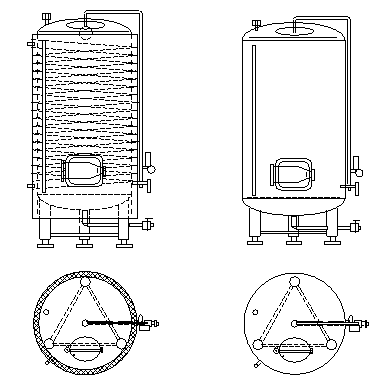 Simple and cheap non-insulated tanks , cooled by cold air. The traditional way of cooling in a lager cellar . The advantage is low cost, but there is also number of disadvantages: high cooling energy demands (it can be affected by the quality of the thermal insulation of walls in the lager cellar) , the impossibility of controlling the maturation ( it is not possible to set different temperatures in individual tanks ), low comfort of work in the lager cellar ( cellar workers are working in very cold and humid environment which is not conducive to their health and working condition ).
Simple and cheap non-insulated tanks , cooled by cold air. The traditional way of cooling in a lager cellar . The advantage is low cost, but there is also number of disadvantages: high cooling energy demands (it can be affected by the quality of the thermal insulation of walls in the lager cellar) , the impossibility of controlling the maturation ( it is not possible to set different temperatures in individual tanks ), low comfort of work in the lager cellar ( cellar workers are working in very cold and humid environment which is not conducive to their health and working condition ).
It is necessary to note that for the brewery cellar with single-shell tanks it is needed to create a cooling box, a room with very good insulation of walls and ceiling and special insulated refrigerator door. The operating costs of cooling are particularly during the summer months, possibly year-round in tropical areas, significantly higher than the brewery cellar with insulated tanks cooled by liquid have. These increased costs to the building and operation usually outweigh the savings from buying cheaper technology brewery.
In contrast, the solution is usually advantageous for air cooling Microbrewery what need to create a refrigerated storage area for filled kegs or bottles of beer, and have not a dedicated storage room. In this case, together with the beer for sale are simultaneously cooled also lager tanks.
2. Maturation tanks with double cooling jacket (liquid-cooled, insulated)
– more elaborate insulated tanks, cooled by glycol or ice water circulating in the double jacket duplicators. The modern way of cooling a lager cellar, which is standard in modern breweries. 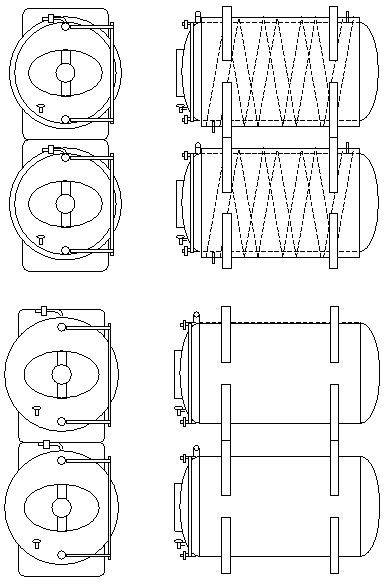 Besides the apparent disadvantage of the higher initial cost, these tanks have only advantages: low cost of cooling operation (cooling only beer, not space), low demand at the place of installation (no need to insulate storage cellar, tanks can be in any room), comfortable operation (in the room with tanks is not need to regulate the teperature ). possibility to control maturation in each tank separately. The only suitable solution for automated management system of the brewery.
Besides the apparent disadvantage of the higher initial cost, these tanks have only advantages: low cost of cooling operation (cooling only beer, not space), low demand at the place of installation (no need to insulate storage cellar, tanks can be in any room), comfortable operation (in the room with tanks is not need to regulate the teperature ). possibility to control maturation in each tank separately. The only suitable solution for automated management system of the brewery.
II. Types of maturation tanks according to the spatial orientation:
1. Maturation tanks with vertical orientation
These tanks in a brewery are “standing” verticaly. Easy for cleaning and sanitation and there is easy access to the tanks from all sides. The disadvantage is the space requirement both in height and in the floor area of the brewery cellar. Vertical maturation tanks are standard solution in modern breweries and this concept is preferred where small space is no fundamental limitation.
2. Maturation tanks with horizontal orientation
The main advantage is saving of place. In the same area we can place a greater number of tanks, if they are arranged in the battery, i.e. several tanks one above another. The disadvantage is the difficult cleaning and sanitation of the tanks which are placed too low or too high. Batteries of the tanks are difficult to clean from outside – the organic contaminants may accumulate in inaccessible surfaces of the tanks and contaminate the beverage produced.
The construction of the maturation tanks depending on allowed overpressure and purpose
The standardized maturation tanks which we product and deliver with our breweries and cider houses are usually designed for max. overpressure 3.0 bar and we test them for overpressure 4.0 bar in our works. Notice : These tanks are classified as pressure vessels according to PED (Directive 2014/68/EU).
According to customer request we can replace all the maturation tanks by combi-serving tanks with a maximum allowed overpressure of 3.0 bar tested by PED with combined functionality both lager and bright beer tanks – then the microbrewery operator can bottle and serve beer from any pressurized lager tank without pumping beer into dedicated serving tanks.
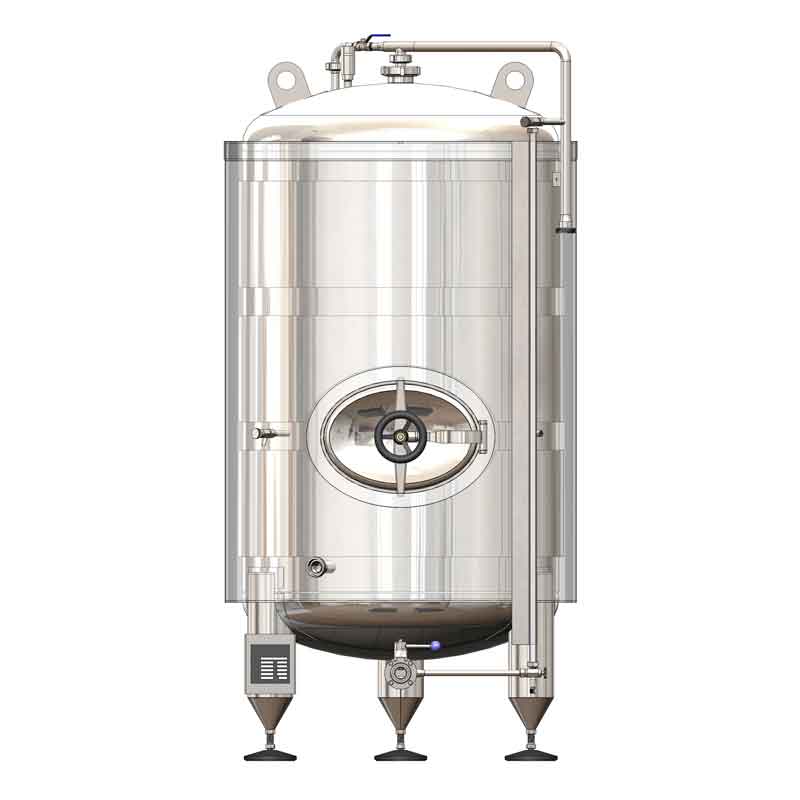 Variations of maturation tanks according to their quality and equipment :
Variations of maturation tanks according to their quality and equipment :
According to requirements and financial possibilities of customers we recognize the maturation tanks with three classes of quality and equipment:
- HQ – HIGH Quality – High quality workmanship of all parts, welded joints and surfaces. The inner surface has a guaranteed roughness Ra<0.8 μm – glossy design. The outer surface is unified. All functional armatures and fittings that have an impact on the reliability and safety of the products are made in Europe or in the USA. Luxury equipment of the tanks. The main advantages are the savings of sanitizing solutions, water and energy, minimized losses of beverages, shorter work time, reduction of production costs. Three years warranty for stainless steel main parts and also for the fittings. The quality class for the most demanding customers.
- SQ – STANDARD Quality – Standard quality workmanship of all parts, welded joints and surfaces. All functional armatures and fittings that have an impact on the reliability and safety of the products are purchased from approved suppliers from Europe or USA. Inspection of all critical welds and joints. The inner surface has a guaranteed roughness Ra=0.8μm – semi glossy design. Usual equipment af the vessels, usual set of fittings. Tanks in this quality class comply with all European regulations for pressure vessels and food processing plants. Two years warranty for stainless steel main parts, two year for the fittings. It is the most often ordered quality variaton of tanks for our customers.
- LQ – LOWER Quality – Lower quality workmanship of all parts, welded joints and surfaces. The most of functional armatures and fittings are purchased from approved suppliers from Asia. The inner and outer surface are not unified. Not guaranteed surface roughness on the inside of the containers. This solution is interesting only for starting small breweries because it saves an investition costs. Unfortunatelly, this brings higer beverage production costs. Longer period of sanitation, greater consumption of the sanitizing solution, energy, labor and hot water. High losses of produced beverages. We don´t offer this quality class for our products, because the equipment with the LQ quality class does not comply with the European regulations for pressure vessels and food processing plants. It is the quality of tanks of very cheap world producers of the tanks.
[table id=3 /]
Our quality Ten: Why to buy maturation tanks just from us?
(why we can not to be the cheapest …)
- We design, manufacture, mounted and testing of all vessels (excluding non-pressure) in accordance with the strict standards and guidelines for pressure vessels (EU Directive PED 97/23 / EC Pressure Equipment). I.e :
-
- Each pressure vessel contains a double-acting air vent valve (prevents against an over pressurization or implosion of the tank during its charging / discharging)
- Each pressure vessel also contains an independent overpressure safety valve (prevents against a very dangerous overpressurization of the vessel and the subsequent explosion during a malfunction or insufficient capacity of the double acting air vent valve)
- Each pressure vessel is designed by certified designer who is qualified for the designing and calculation of pressure vessels.
- Production documentation for each pressure vessel containing static strength calculation, the exact description of a right manufacturing process, including the required types of welds, thickness of material, critical points solutions.
- All the manufactured pressure vessels are subjected to rigorous testing of tightness and porosity of welds, using a special liquid that detects even the slightest unwanted leaks, pores or micro-cracks = The Penetration Test
- Pressure vessels are tested at overpressure which is at least 1 bar higher than the overpressure, for which containers are certified.
- The Protocol on the tightness and pressure tests and the EU declaration of conformity are issued to all pressure vessels. We also attach the Pressure vessel passport, at the request of the customer.
- Manufacturing processes, design drawings, manufacturing, tightness and pressure tests are supervised by an inspector of TÜV SÜD Czech or another certified company, supplying quality control and compliance with European standards.
- Each pressure vessel contains an indelible nameplate with the obligatory name of the manufacturer, the ultimate pressure or other data that uniquely identifies the concrete pressure vessel in accordance with EU PED 97/23 / EC
- Optionally we can produce the pressure equipment according to the conditions and standards of ASME, GOST-R or GUM certification rules. In this case, we charge an extra surcharge for the special certification :
- PED certification … is included in the price
- ASME certification … surcharge 10%
- GUM certification … surcharge 5% – We ensure all necessary technical equipment of the tank (GUM compliant), a customer pays and handles the certification process for the tank on site.
- GOST-R certification … surcharge 10%
-
- We produce food containers fundamentally from food stainless steel that fully comply with the Regulation of the European Parliament and Council Regulation EC no. 1935/2004. These materials do not release their constituents to food in quantities which could endanger human health or bring about an unacceptable changes in the composition of food or a deterioration in their organoleptic and sensory characteristics in contact with food under normal or foreseeable conditions. We do not use cheap stainless steel with lower quality, which will soon lose their corrosion resistance and indifference to food, especially after repeated contact with the sanitation solutions.
- We are looking into suppliers of construction and installation materials and components from which we produce equipment for food production and handling. We do not buy any material from importers who are unable to prove its European origins and characteristics.
- All the tanks, which we design for maturation, maturation and storage of beverages, have optimized dimensions for the maturation processes, maturation process, carbonation, carried out in accordance with technological standards for beverages production. We do not set the dimensions of the containers by an unqualified “eyeball” estimate .
- All containers that are made in HQ quality class, are produced with the guaranteed inner surface roughness of Ra < 0.8 microns , containers that are made in SQ quality class, are produced with the guaranteed inner surface roughness of Ra = 0.8 microns (except in very small containers and terminating welds on intermediate vessels), which is the European standard prescribed roughness of the inner surfaces of the containers that come into contact with food and carried with their sanitation alkalis and acids. Guaranteed roughness of the inner surface of the vessel is extremely important to ensure thorough cleaning and sanitation tanks. This is an essential prerequisite for achieving purity and sterility of food production equipment. We guarantee this limited roughness for 100% of the interior surface . We repeatedly do measurements of all internal surfaces of tanks with the special oughness-meter TR-130 during all their manufacturing process. We polish the inner surface of the tank until the desired roughness is reached.
- Each container is designed and manufactured in such a way as to ensure easy cleaning and sanitizing of all surfaces that come into contact with food. Therefore, the vessels are equipped with at least one sanitation shower, removable and sanitizable level-indicators and sample cooks. We do not use any cheap fittings, for which the manufacturer has failed to sanitary design and cleanability.
- Tanks in HQ quality class have an united outer surface. All joints of the outer sheets (thickness at least 2 mm) are either welded or completely sealed. This is important to prevent ingress of moisture into the double casing, moistening the insulating material and the loss of insulating ability. This ensures a consistent quality and insulating capacity of the tanks. For containers in LQ quality the external sheets are usually riveted and they have a thickness of at least 1 mm.
- We isolate all the pressure vessels by quality PU foam. The insulating polyuretan foam is professionally applied to the insulating space of the container so as to avoid formation of thermal bridges, unisolated empty space or deformation of containers.We do not use cheap little functional replacements for the isolation of containers such as insulating wool, polystyrene beads, inexpertly applied foam.
- Diameters of nozzles, valves and piping are sized correctly according to the volume and vessel function – we do not mount underpowered functional elements on the tanks.
- The warranty for the tanks produced in HQ is at least 24-36 months. The warranty on vessel in SQ quality is 18 months. The practical life of the vessels is usually several decades, while elements with lower lifetime (dampers, valves, seals, etc.) can usually to be easily replaced with a new standardized elements of the same or another manufacturer.
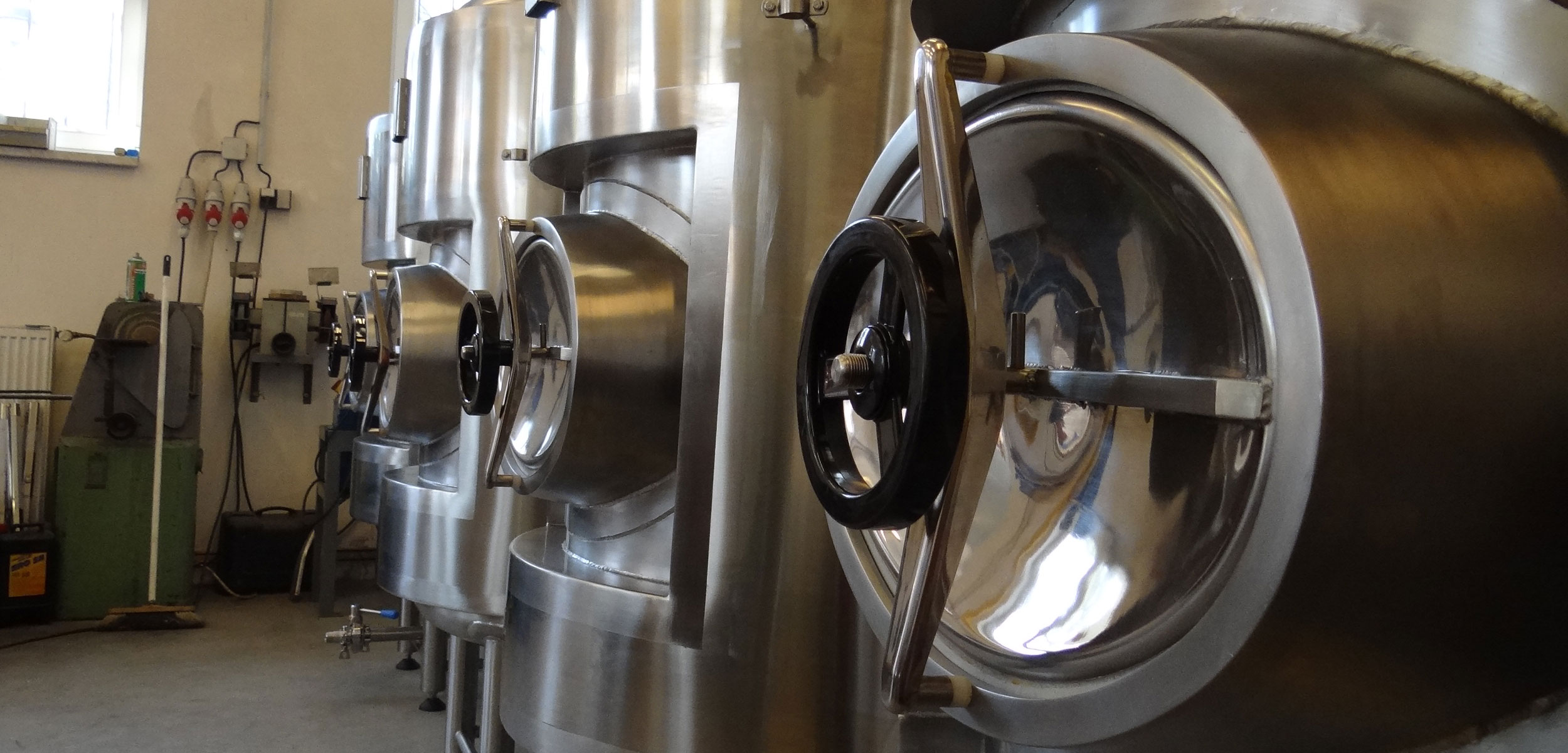
Our recommendation:
If you are comparing our prices with competitors, please always make sure that any other manufacturer guarantees the same quality as we offer.
Technical data of lager tanks – four variants maturing vessels:
- Maturation vertical tanks – insulated, liquid-cooled
- Maturation vertical tanks – non-insulated, air-cooled
- Maturation horizontal tanks – insulated, liquid-cooled
- Maturation horizontal tanks – non-insulated, air-cooled

